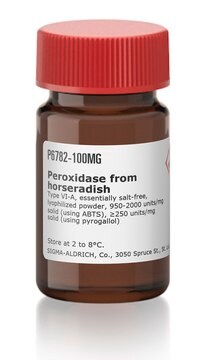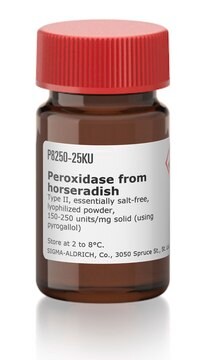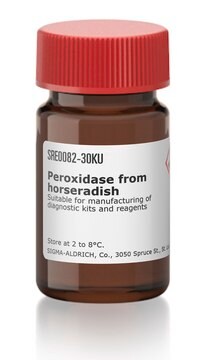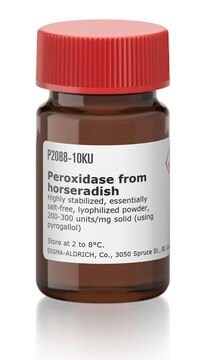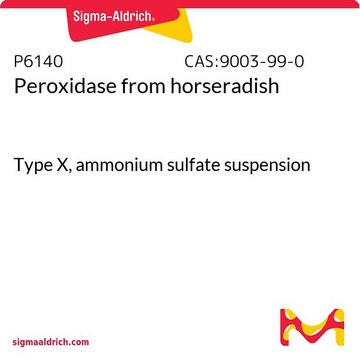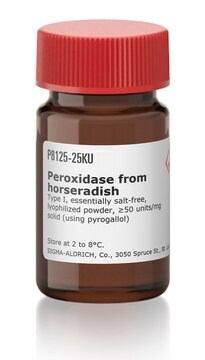Descrizione generale
La perossidasi di rafano si isola dalle radici del rafano (Amoracia rusticana) e appartiene al gruppo delle perossidasi con ferroprotoporfirina. L′HRP è un polipeptide a singola catena che contiene quattro ponti disolfuro. È una glicoproteina che contiene il 18% di carboidrati. La composizione dei carboidrati include galattosio, arabinosio, xilosio, fucosio, mannosio, mannosamina e galattosamina, a seconda del singolo isozima. Il peso molecolare (circa 44 kDa) include la catena polipeptidica (33.890 Dalton), la emina con Ca2+ (circa 700 Dalton) e il carboidrato (circa 9.400 Dalton). Esistono almeno sette isoenzimi di HRP. Il punto isoelettrico degli isoenzimi della perossidasi di rafano è compreso fra 3,0 e 9,0.
HRP is a single chain polypeptide containing four disulfide bridges. It is a glycoprotein containing 18% carbohydrate. The carbohydrate composition consists of galactose, arabinose, xylose, fucose, mannose, mannosamine, and galactosamine depending upon the specific isozyme. Its molecular weight (~44 kDa) includes the polypeptide chain (33,890 Daltons), hemin plus Ca2+ (~700 Daltons), and carbohydrate (~9,400 Daltons). At least seven isozymes of HRP exist. The isoelectric point for horseradish peroxidase isozymes ranges from 3.0 - 9.0.
Applicazioni
Horseradish peroxidase (HRP) is isolated from horseradish roots (Amoracia rusticana) and belongs to the ferroprotoporphyrin group of peroxidases. It is used in biochemistry applications such as western blots, ELISA and Immunohistochemistry. Horseradish peroxidase is used to amplify a weak signal and increase detectability of a target molecule, such as a protein. Product P8415, type XII, is an essentially salt free lyophilized powder. It is a further purification of product P8375. It is commonly used to determine amounts of glucose and peroxides in solution. It has been used in an aspergillus fumigatus rapid susceptibility assay.
Peroxidase from horseradish has been used to initiate peroxidase-coupled assay. It has also been used in the preparation of β-galactosidase (β-gal) stock solution.
The enzyme has been used to determine H2O2 production in tobacco BY-2 cells using a spectrofluorimetric method.
Azioni biochim/fisiol
HRP readily combines with hydrogen peroxide (H2O2) and the resultant [HRP-H2O2] complex can oxidize a wide variety of hydrogen donors. The optimal pH is 6.0-6.5 and the enzyme is most stable in the pH range of 5.0-9.0. HRP can be conjugated to antibodies by several different methods including glutaraldehyde, periodate oxidation, through disulfide bonds, and also via amino and thiol directed cross-linkers. It is smaller and more stable than the enzyme labels β-galactosidase and alkaline phosphatase and hence, it is the most desired label. Also, its glycosylation leads to lower non-specific binding. It is also used for the determination of glucose and peroxides in solution.
When incubated with a substrate, horseradish peroxidase produces a coloured, fluorimetric, or luminescent derivative of the labeled molecule, allowing quantification. Horseradish peroxidase has been shown to slightly reduce the level of inhibition in a cydAB mutant. Known inhibitors are sodium azide, cyanide, L-cystine, dichromate, ethylenethiourea, hydroxylamine, sulfide, vanadate, p-aminobenzoic acid, and Cd2+, Co2+, Cu2+, Fe3+, Mn2+, Ni2+, and Pb2+ ions.
Definizione di unità
Una unità di pirogallolo forma 1,0 mg di purpurogallina da pirogallolo in 20 secondi a pH 6,0 e 20 °C.
Nota sulla preparazione
Chromatographically purified
Risultati analitici
Il RZ (Reinheitszahl) è il rapporto di assorbanza A403/A275 determinato a 0,5-1,0 mg/mL in acqua deionizzata. Misura il contenuto di emina, non l′attività enzimatica. Anche preparazioni con un RZ elevato possono avere una bassa attività enzimatica.
Preliminary isoelectric focusing data indicates this is primarily isoenzyme C

